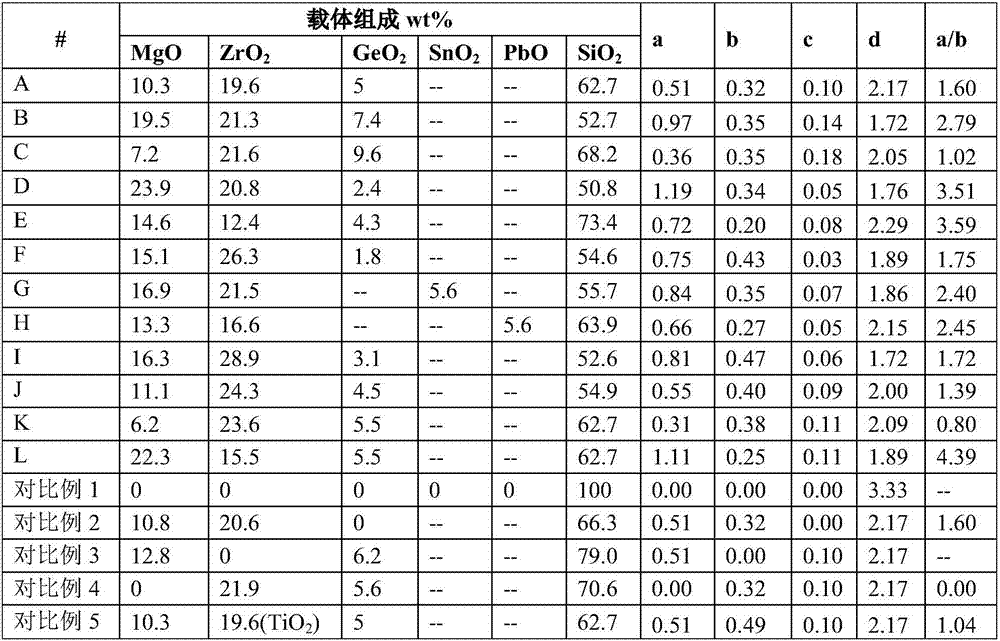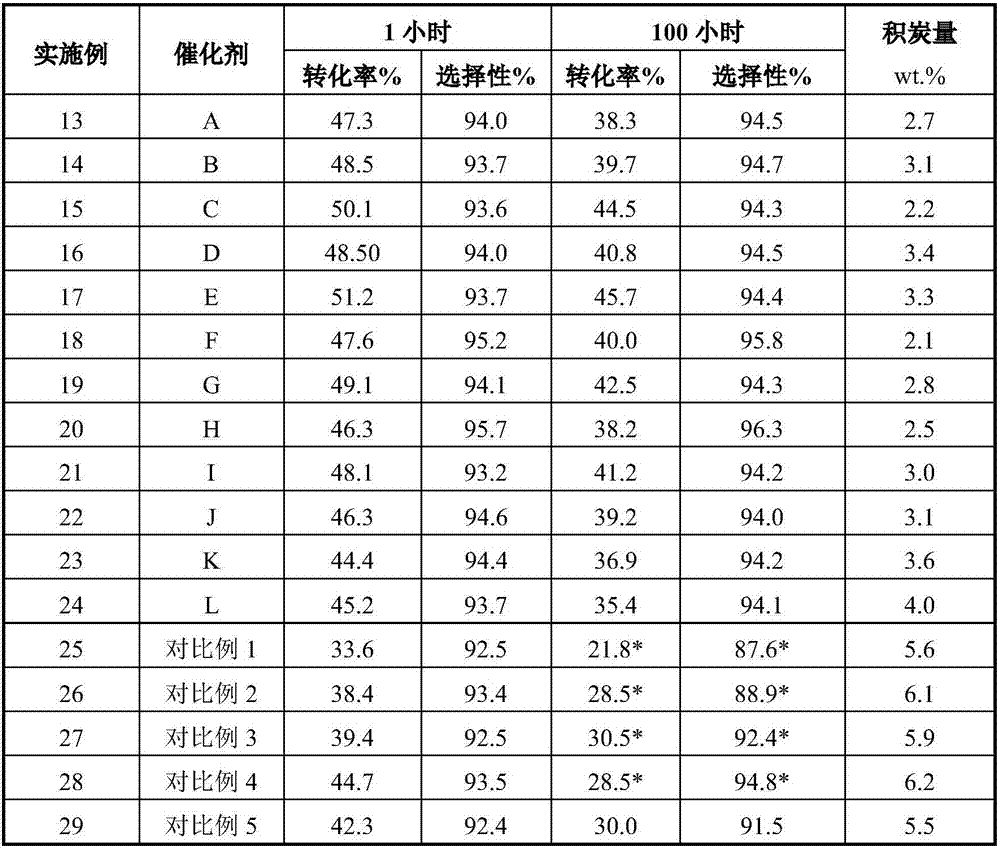Catalyst for preparing light olefins by light alkane dehydrogenation and preparation method of catalyst
A technology of low-carbon alkanes and low-carbon olefins, applied in the field of catalyst carriers and their preparation, can solve the problems of rapid decline in conversion rate, fast carbon deposition of catalysts, and short single-pass life.
- Summary
- Abstract
- Description
- Claims
- Application Information
AI Technical Summary
Problems solved by technology
Method used
Image
Examples
Embodiment 1
[0026] Get 131.1g magnesium nitrate (Mg(NO 3 ) 2 6H 2 O), 165.4g zirconium nitrate (Zr(NO 3 ) 4 5H 2 O) Dissolve in 1000ml deionized water, then add 130.2g of silicon dioxide (80-115 microns in particle size) and 10.0g of germanium oxide (80-110 microns in particle size) to form a suspension; at 25°C, under vigorous stirring, Slowly add 6% ammonia water dropwise into the mixed aqueous solution to form a precipitate, control the pH value to 8.0, stir for 2 hours, filter, wash with deionized water for 3 times, dry at 120°C, crush, sieve, and Calcined at 680°C for 18 hours to obtain a composite silica carrier. Pore volume 0.62cm 3 / g, specific surface area 88m 2 / g. The composition and properties of the carrier are shown in Table 1.
[0027] The obtained carrier adopts impregnation technology to load the platinum component, that is, at room temperature, 15.0 g of the obtained carrier is impregnated with chloroplatinic acid (H 2 PtCl 6 6H 2 O, 0.12g) in aqueous so...
Embodiment 2
[0030] Get 248.1g magnesium nitrate (Mg(NO 3 ) 2 6H 2 O), 179.8g zirconium nitrate (Zr(NO 3 ) 4 5H 2 O) Dissolve in 1000ml deionized water, then add 103.6g of silicon dioxide (76-120 microns in particle size) and 14.8g of germanium oxide (50-100 microns in particle size) to form a suspension; at 25°C, under vigorous stirring, Slowly add 20% ammonia water dropwise into the mixed aqueous solution to form a precipitate, control the pH value to 8.0, stir for 2 hours, filter, wash with deionized water for 3 times, dry at 120°C, crush, sieve, and Calcined at 780°C for 14 hours to obtain a composite silica carrier. Pore volume 0.80cm 3 / g, specific surface area 115m 2 / g. The composition and properties of the carrier are shown in Table 1.
[0031] The obtained carrier adopts impregnation technology to load the platinum component, that is, at room temperature, 15.0 g of the obtained carrier is impregnated with chloroplatinic acid (H 2 PtCl 6 6H 2 O, 0.12g) in aqueous ...
Embodiment 3
[0034] Get 91.6g magnesium nitrate (Mg(NO 3 ) 2 6H 2 O), 182.3g zirconium nitrate (Zr(NO 3 ) 4 5H 2 O) Dissolve in 1000ml of deionized water, then add 123.2g of silicon dioxide (30-80 microns in particle size) and 19.6g of germanium oxide (50-90 microns in particle size) to form a suspension; at 25°C, under vigorous stirring, Slowly add 15% ammonia water dropwise into the mixed aqueous solution to form a precipitate, control the pH value to 8.0, stir for 2 hours, filter, wash with deionized water for 3 times, dry at 120°C, crush, sieve, and Calcined at 700°C for 16 hours to obtain a composite silica carrier. Pore volume 0.74cm 3 / g, specific surface area 109m 2 / g. The composition and properties of the carrier are shown in Table 1.
[0035] The obtained carrier adopts impregnation technology to load the platinum component, that is, at room temperature, 15.0 g of the obtained carrier is impregnated with chloroplatinic acid (H 2 PtCl 6 6H 2 O, 0.12g) in aqueous ...
PUM
| Property | Measurement | Unit |
|---|---|---|
| specific surface area | aaaaa | aaaaa |
| diameter | aaaaa | aaaaa |
| specific surface area | aaaaa | aaaaa |
Abstract
Description
Claims
Application Information
 Login to View More
Login to View More - R&D
- Intellectual Property
- Life Sciences
- Materials
- Tech Scout
- Unparalleled Data Quality
- Higher Quality Content
- 60% Fewer Hallucinations
Browse by: Latest US Patents, China's latest patents, Technical Efficacy Thesaurus, Application Domain, Technology Topic, Popular Technical Reports.
© 2025 PatSnap. All rights reserved.Legal|Privacy policy|Modern Slavery Act Transparency Statement|Sitemap|About US| Contact US: help@patsnap.com



